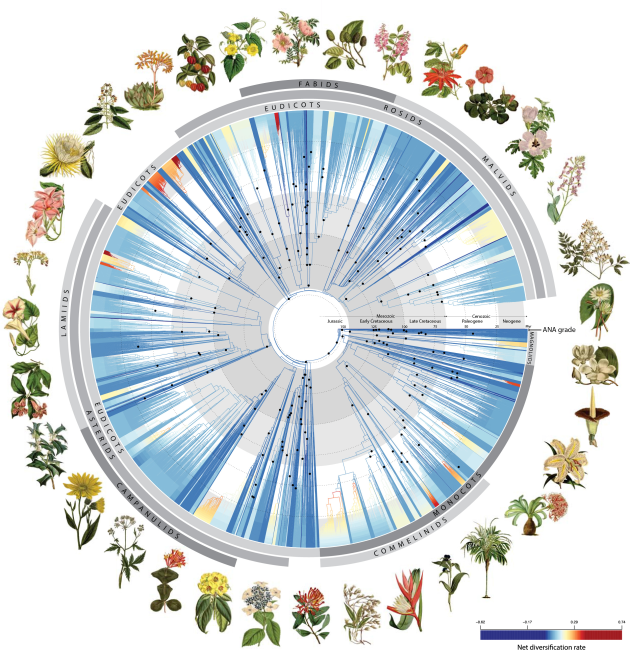Tree of life: the most comprehensive ever!
Botanic Gardens of Sydney have collaborated in a global team of 279 scientists led by Kew Gardens to assemble the most comprehensive flowering plants ‘Tree of Life’ ever.
Published in the journal Nature, the study signifies a new milestone in understanding the evolutionary history of flowering plants, known as angiosperms. Scientists across 27 countries collaborated to unveil the history of how these plants have surpassed all other forms of plant life.

Dr Russell Barrett Hervé Sauquet (left) at the Herbarium. Credit: Botanic Gardens of Sydney
"This extraordinary global effort effort revealed that early flowering plants did indeed explode in diversity in the Early Cretaceous, giving rise to over 80% of the major lineages that exist today,” said Head of Plant Discovery and Evolution Research at Botanic Gardens of Sydney, Dr Hervé Sauquet.
Like a periodic table for plants, the new 'Tree of Life' will accelerate the discovery and conservation of plant species under threat from climate change and biodiversity loss and help scientists find new medicines.

Left to right: Natalie Karbowiak, Russell Barrett and Alex Dayde, from Botanic Gardens of Sydney sampling specimens for the New South Wales Plant Tree of Life. Credit: Botanic Gardens of Sydney
The big flowering plant bang
For generations, scientists struggled to understand how flowering plants came to dominate Earth’s lands. These plants, known as angiosperms, exist in almost every environment and account for about 90% of all known plant life on the planet, forming vital ecosystems, habitats, and food sources.
About 140 million years ago, there was an explosion in the existence of these plants. They quickly overtook other vascular plants, including their non-flowering, closest living relatives like conifers, cycads and ginkgos (gymnosperms). Charles Darwin was of the first to be baffled by their rapid appearance, describing it as an “abominable mystery” in his 1879 letter to Joseph Dalton Hooker, Director of the Royal Botanic Gardens, Kew.
Using 1.8 billion letters of genetic code from over 9,500 species, scientists across 27 countries collaborated to unveil the history of how these plants have surpassed all other forms of plant life. Flowering plants, known as angiosperms, exist in almost every environment and account for about 90% of all known plant life on the planet, forming vital ecosystems, habitats, and food sources. Among the species studied for this paper, more than 800 have never had their DNA sequenced before.

Dr Hannah McPherson prepares plant samples collected from the National Herbarium of New South Wales for sequencing. Credit: Botanic Gardens of Sydney
Dr Hannah McPherson, Collections Manager at the National Herbarium of NSW (part of Botanic Gardens of Sydney) added the study shows how crucial herbaria are in unlocking the past. “Some of the older plants used were collected before DNA sequencing was even possible, which is mind-blowing considering what we can now learn from these stored treasures,” she said.
The team at Royal Botanic Gardens, Kew, successfully sequenced a sandwort specimen (Arenaria globiflora) collected nearly 200 years ago in Nepal and, despite the poor quality of its DNA, were able to place it in the tree of life.
“Plans are underway to use the same technology on a massive scale at Botanic Gardens of Sydney. We want to create the first complete evolutionary tree for all 7,000 native seed plants in New South Wales”, added Dr Russell Barrett, Systematic Botanist at Botanic Gardens of Sydney.
Read the full paper in Nature
Learn more at www.botanicgardens.org.au



